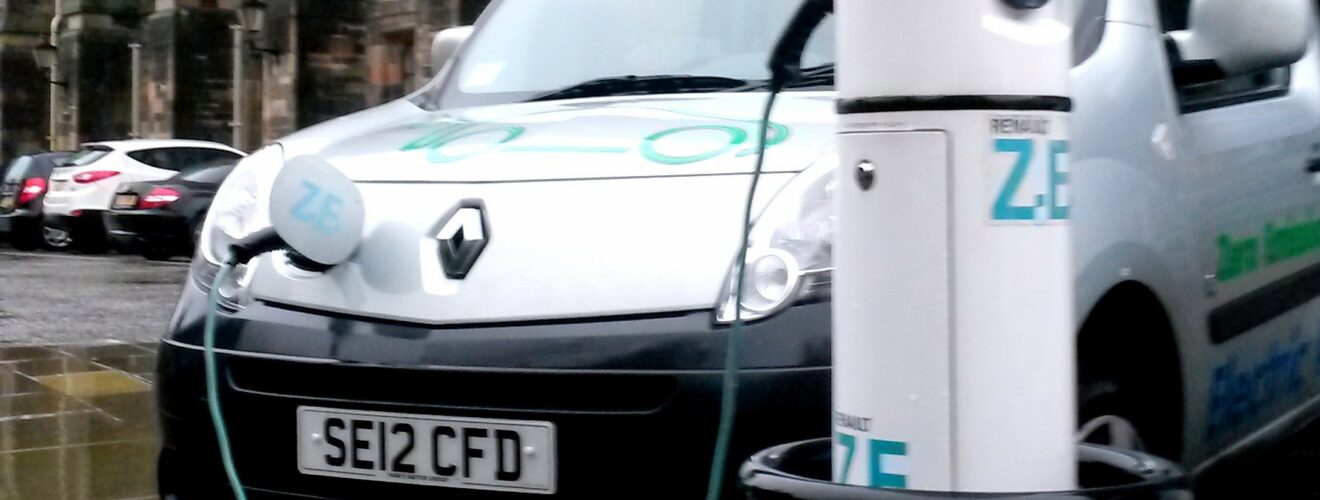Electric vehicles – driving us forward to a greener future

5 February 2015
Many renewable energy sources are now working remarkably efficiently and many scientists feel that with sufficient financing, continuing research and real dedication from world leaders that these could eventually take over from fossil fuels entirely. For example, in 2010, Alec Salmond claimed that Scotland could soon be run entirely on green energy saying, “I’m confident that by 2025 we will produce at least 100% of our electricity needs from renewables alone, and together with other sources it will enable us to become a net exporter of clean, green energy” – he was perhaps using slightly optimistic numbers but as technologies improve a nation run on 100% green energy becomes less and less unrealistic*.
However, even in a country run entirely with wind, waves and sunshine we will presumably still occasionally need to travel using something a little faster than a bicycle. According to David MacKay’s (free) book, Sustainable Energy – Without the Hot Air, roughly one third of the UK’s energy goes into transport 1. Insisting upon cycling, walking and increased use of public transport helps a bit and when you use public transport it turns out that trains are more efficient than buses – so long as they’re both full of passengers. Flights, of course, are still very far from being green.
So public transport is great but it’s a little naive to assume that people will happily give up their cars. There’s now a great deal of work being poured into making road vehicles more efficient but also into developing electric and hybrid vehicles. Efficient electric cars are greener than cars that run on petrol or diesel and the benefits increase further as the grid itself gets cleaner. There’s also the social effect; when people switch to electric cars they tend think about their other behaviours more, they switch to energy saving bulbs, they turn their thermostats down, they stop leaving their televisions on stand-by. In September 2014 the US clean technology website, cleantechnica.com, reported that it’s not unusual for a person’s energy bills to drop after they buy an electric car due to other changes in their behaviour.
Now people are looking at the potential for electric cars to do even more. Engineers and scientists have been considering ways to deal with power fluctuations associated with green energy. It’s a problem anyone could see coming: When the wind blows harder you get more wind power, but unless the wind happens to blow hardest at 6pm when everyone starts cooking their dinner this might not be useful. You get plenty of solar power on sunny days, but you need extra heating on miserable ones or when it gets cooler at night. Hydroelectric power is relatively predictable but (at least at the moment) can’t be relied upon as the sole source of juice. How do we mitigate the mismatch between supply and demand?
At present this is chiefly done with green hydroelectric plants and with less green, traditional coal, gas and oil plants. In terms of the hydroelectric plants, it’s quite easy to increase supply to the grid during a surge by letting extra water flow through the turbines and it’s quite easy to store it up for next time by letting water accumulate in the dam. Likewise with traditional fossil fuel plants if you need more energy you burn more fuel. Nuclear power stations, by comparison, require very long waiting times between changes in output so, in spite of their huge capacity for generating power, they lack flexibility.
However, if future energy sources are to be increasingly green, these fluctuations are going to be much more common and both large and small fluctuations can be expected. Hydroelectric could use a helping hand.
This is where electric cars come in. A paper published in the New Journal of Physics confirms the possibilities that have been speculated about for some time; with a large fleet of electric cars you can handle fluctuations in grid supply 2. It’s estimated that by 2020 1-2% of the total vehicles in the US will be PEVs (Plug-in Electric Vehicles). The average PEV is parked and plugged in around 96% of the time. All those cars with all those batteries, just waiting to be driven somewhere – it’s a waste to not make use of that.
Consider this, solar power drops at night. People drive less at night. If their cars are plugged in they could be put into discharge mode, providing electricity to meet the smaller, night-time demand. Their drivers don’t need them until the morning, so all that’s needed is a smart charger that makes sure the car is ready to take its owner to work, where it can be plugged in again. Now, let’s say there’s a sudden surge in wind energy that day, ordinarily the extra energy would be lost, but with all those batteries waiting to be charged it can be stored again – ready for when people need to get home or for when there’s a lull in production. There’s also the possibility for the car to include a smart system that learns the habits of its driver and adjusts its charging accordingly – such systems already exists for home thermostats and could easily be adapted for other uses such as this. The GIST’s own Sean Leavey has worked on a similar system for laptop batteries and chargers and concluded that it would be possible to make a difference even with batteries of that capacity – the capacity of an electric car’s battery is clearly far greater 3.
This could never work with just a handful of vehicles, of course, but with large numbers it could work very well indeed. So well, that the authors speculate that such a system could reduce utility operating costs and even generate revenue. You can be as cynical as you like about humanity’s capacity for change but you’ll still have to admit that if there’s a way for someone to make money out of it, it’ll probably happen sooner or later.
I for one welcome the kind of energy tycoon who makes their millions out of pushing electric vehicles with smart charging systems, rather than the kind who makes it drilling for oil in countries with fragile governments. Or I will, as soon as they show up.
*Perhaps it should be noted that, nobel though Mr Salmond’s intentions may have been, a document released in August 2011 on scotland.gov.uk and titled 2020 routemap for renewable energy in Scotland laid out plans for 100% of Scotland’s electricity to come from renewables by 2020.
Specialist edited by Sean Leavey and copy edited by Charlie Stamenova.
References
- D. J. C MacKay, Sustainable energy without the hot air, UIT, 1st edn, 2008
- A. Gajduk, M. Todorovski, J. Kurths, L. Kocarev, Improving power grid transient stability by plug-in electric vehicles, New Journal of Physics 16(115011), 2014
- S. Hild, S. Leavey, C. Graf, B. Sorazu, Smart charging technologies for portable electronic devices, IEEE transactions on smart grid 5(1), 2013










